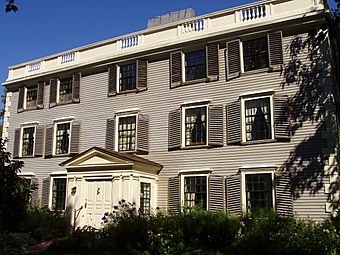Hooper–Lee–Nichols House facts for kids
Quick facts for kids |
|
|
Hooper–Lee–Nichols House
|
|

The Hooper–Lee–Nichols House, front facade
|
|
| Location | Cambridge, Massachusetts |
|---|---|
| Built | 1685 |
| Architect | Joseph E. Chandler |
| NRHP reference No. | 79000355 |
| Added to NRHP | June 15, 1979 |
The Hooper–Lee–Nichols House is a very old and important home in Cambridge, Massachusetts. It was first built in 1685. Over the years, it has been made bigger and changed many times. You can find it at 159 Brattle Street in Cambridge. This house is the second-oldest in the city. Only the Cooper–Frost–Austin House, built around 1681–1682, is older. Today, the Hooper–Lee–Nichols House is the main office for History Cambridge. This group used to be called the Cambridge Historical Society.
Contents
The House's Long History
Early Days and Changes
The house was first built in 1685 by a doctor named Richard Hooper. It started as a typical farmhouse from that time. What was special for a simple house back then was that its ceilings were plastered. When Dr. Hooper passed away in 1691, his wife took in people who paid to live there. The house started to get run down. She died in 1701, and the house continued to decline.
In 1716, Dr. Hooper's son, Dr. Henry Hooper, took over the house. He paid off his mother's debts. He then bought another house, took it apart, moved it to this spot, and put it back together. This made the Hooper–Lee–Nichols House twice as big! He also added a lean-to section and rebuilt the chimney. The new chimney even had ovens for cooking. In 1733, he sold the house to Cornelius Waldo. Mr. Waldo added a third floor and started changing the house to the popular Georgian style.
New Owners and Renovations
Judge Joseph Lee bought the house in 1758. He added an enclosed porch at the front. He also put stucco on the west wall of the house. Judge Lee supported the British during the American Revolution. Because of this, he left his house when the war began. However, he came back to live there in 1777.
In 1850, George and Susan Nichols rented the house. They started to make many improvements. They made the back of the house larger. They also added a fancy railing on the roof. This railing had parts that once belonged to Saint Paul's Cathedral in Boston. Later, in 1916, Austin White, a relative of the Nichols family, made more changes. He removed the two-story back part of the house and rebuilt it to be a full three stories tall. Finally, in 1923, Frances Emerson received the house as a Christmas gift from her father. Her husband was a dean at MIT for many years.
Modern Use of the House
Frances Emerson gave the house to the Cambridge Historical Society. The Society officially took ownership in 1957. The house was added to the National Register of Historic Places in 1979. This list recognizes important historical places in the United States. In the early 1980s, the Society did a lot of work to fix up and strengthen the house. More big renovations were done in 2013.
The Cambridge Historical Society changed its name to History Cambridge in 2021. In 2025, the organization announced that it was looking for a new main office. They also said they would be selling the historic house. They explained that the costs to keep up such an old house were very high.
See also



